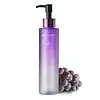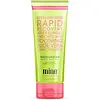What's inside
What's inside
 Key Ingredients
Key Ingredients

 Benefits
Benefits

 Concerns
Concerns

 Ingredients Side-by-side
Ingredients Side-by-side

Acer Mono Sap
Skin ConditioningAlcohol
AntimicrobialGlycerin
HumectantPEG-8
HumectantSea Water
HumectantMaris Aqua
HumectantButylene Glycol
HumectantPropylene Glycol
HumectantWater
Skin ConditioningBetula Alba Bark/Leaf Extract
AstringentCastanea Sativa Bark Extract
Skin ConditioningOlea Europaea Fruit Extract
BleachingPinus Sylvestris Bark Extract
PerfumingRibes Nigrum Fruit Extract
AstringentVaccinium Vitis-Idaea Fruit Extract
AntioxidantVitis Vinifera Fruit Extract
Skin ConditioningTriticum Vulgare Flour Extract
Skin ConditioningOryza Sativa Extract
AbsorbentZea Mays Germ Extract
Skin ConditioningGlycine Soja Seed Extract
Skin ConditioningOryza Sativa Bran Extract
Skin ConditioningBiosaccharide Gum-1
HumectantPEG-60 Hydrogenated Castor Oil
EmulsifyingMethylparaben
PreservativeCarbomer
Emulsion StabilisingArginine
MaskingPanthenol
Skin ConditioningCreatine
Skin ConditioningHydroxypropyl Methylcellulose
Emulsion StabilisingPhenoxyethanol
PreservativeMel Powder
AbrasiveDisodium EDTA
Ethylhexyl Methoxycinnamate
UV AbsorberParfum
MaskingSodium Hyaluronate
HumectantCI 15510
Cosmetic ColorantAcer Mono Sap, Alcohol, Glycerin, PEG-8, Sea Water, Maris Aqua, Butylene Glycol, Propylene Glycol, Water, Betula Alba Bark/Leaf Extract, Castanea Sativa Bark Extract, Olea Europaea Fruit Extract, Pinus Sylvestris Bark Extract, Ribes Nigrum Fruit Extract, Vaccinium Vitis-Idaea Fruit Extract, Vitis Vinifera Fruit Extract, Triticum Vulgare Flour Extract, Oryza Sativa Extract, Zea Mays Germ Extract, Glycine Soja Seed Extract, Oryza Sativa Bran Extract, Biosaccharide Gum-1, PEG-60 Hydrogenated Castor Oil, Methylparaben, Carbomer, Arginine, Panthenol, Creatine, Hydroxypropyl Methylcellulose, Phenoxyethanol, Mel Powder, Disodium EDTA, Ethylhexyl Methoxycinnamate, Parfum, Sodium Hyaluronate, CI 15510
Paraffinum Liquidum
EmollientTriisononanoin
Skin ConditioningCetearyl Ethylhexanoate
EmollientIsopropyl Myristate
EmollientRetinyl Palmitate
Skin ConditioningTocopheryl Acetate
AntioxidantAnthemis Nobilis Flower Oil
MaskingLavandula Angustifolia Oil
MaskingRosmarinus Officinalis Leaf Oil
MaskingCalendula Officinalis Flower Extract
MaskingHelianthus Annuus Seed Oil
EmollientGlycine Soja Oil
EmollientBHT
AntioxidantBisabolol
MaskingParfum
MaskingAmyl Cinnamal
PerfumingBenzyl Salicylate
PerfumingCitronellol
PerfumingCoumarin
PerfumingEugenol
PerfumingGeraniol
PerfumingHydroxycitronellal
PerfumingHydroxyisohexyl 3-Cyclohexene Carboxaldehyde
MaskingLimonene
PerfumingLinalool
PerfumingAlpha-Isomethyl Ionone
PerfumingCI 26100
Cosmetic ColorantAloe Arborescens Leaf Juice
Skin ConditioningTriethanolamine
BufferingPropylene Glycol
HumectantDiazolidinyl Urea
PreservativeIodopropynyl Butylcarbamate
PreservativeParaffinum Liquidum, Triisononanoin, Cetearyl Ethylhexanoate, Isopropyl Myristate, Retinyl Palmitate, Tocopheryl Acetate, Anthemis Nobilis Flower Oil, Lavandula Angustifolia Oil, Rosmarinus Officinalis Leaf Oil, Calendula Officinalis Flower Extract, Helianthus Annuus Seed Oil, Glycine Soja Oil, BHT, Bisabolol, Parfum, Amyl Cinnamal, Benzyl Salicylate, Citronellol, Coumarin, Eugenol, Geraniol, Hydroxycitronellal, Hydroxyisohexyl 3-Cyclohexene Carboxaldehyde, Limonene, Linalool, Alpha-Isomethyl Ionone, CI 26100, Aloe Arborescens Leaf Juice, Triethanolamine, Propylene Glycol, Diazolidinyl Urea, Iodopropynyl Butylcarbamate
Alternatives
Ingredients Explained
These ingredients are found in both products.
Ingredients higher up in an ingredient list are typically present in a larger amount.
Parfum is a catch-all term for an ingredient or more that is used to give a scent to products.
Also called "fragrance", this ingredient can be a blend of hundreds of chemicals or plant oils. This means every product with "fragrance" or "parfum" in the ingredients list is a different mixture.
For instance, Habanolide is a proprietary trade name for a specific aroma chemical. When used as a fragrance ingredient in cosmetics, most aroma chemicals fall under the broad labeling category of “FRAGRANCE” or “PARFUM” according to EU and US regulations.
The term 'parfum' or 'fragrance' is not regulated in many countries. In many cases, it is up to the brand to define this term.
For instance, many brands choose to label themselves as "fragrance-free" because they are not using synthetic fragrances. However, their products may still contain ingredients such as essential oils that are considered a fragrance by INCI standards.
One example is Calendula flower extract. Calendula is an essential oil that still imparts a scent or 'fragrance'.
Depending on the blend, the ingredients in the mixture can cause allergies and sensitivities on the skin. Some ingredients that are known EU allergens include linalool and citronellol.
Parfum can also be used to mask or cover an unpleasant scent.
The bottom line is: not all fragrances/parfum/ingredients are created equally. If you are worried about fragrances, we recommend taking a closer look at an ingredient. And of course, we always recommend speaking with a professional.
Learn more about ParfumPropylene Glycol is an odorless, colorless liquid. As a humectant, it helps skin retain moisture. It also aids in delivering active ingredients.
Another role of this ingredient is preventing a product from melting or freezing. Propylene glycol also adds antimicrobrial properties to a product, elongating product lifespan.
This ingredient is considered an organic alcohol and commonly added into both cosmetics and foods.
Those with sensitive skin or conditions may develop a rash when using this ingredient.
Learn more about Propylene Glycol